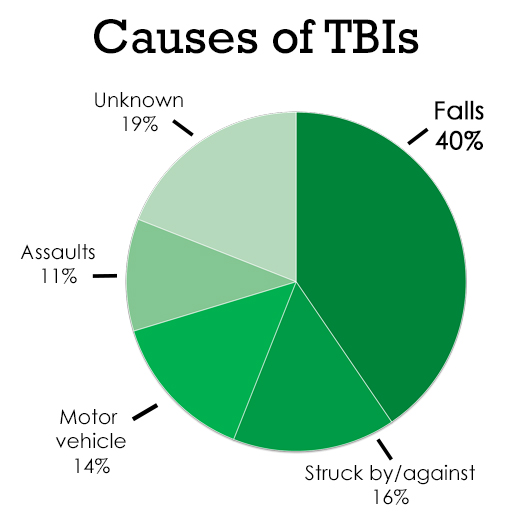According to the Brain Injury Association of America (BIA), “…every day, 137 people in the U.S. die because of a TBI-related injury…” (BIA, 2015). So, what is the leading cause of these Traumatic Brain Injuries? It may not be what you think.
When you hear someone has suffered or survived a Traumatic Brain Injury (TBI), does the scene of a car accident flash through your head? At only 14.5%, motor vehicles are actually the 3rd leading cause of TBIs.
The number one cause of many TBIs is due to falls.¹
It is also no coincidence that Brain Injury Awareness Day (March 16) is in the middle of National Patient Safety Week (March 13-19). As a healthcare provider, it is important that we pass along information to protect our clients and our families. Below is a compiled list of fall risk factors as well as prevention and safety tips.
What Conditions Make You More Likely to Fall?²
Research has identified many conditions that contribute to falling. These are called risk factors. Many risk factors can be changed or modified to help prevent falls. Please note that most falls are caused by a combination of risk factors. The more risk factors a person has, the greater their chances of falling. They include:
- Lower body weakness
- Vitamin D deficiency (that is, not enough vitamin D in your system)
- Difficulties with walking and balance
- Use of medicines, such as tranquilizers, sedatives, or antidepressants. Even some over-the-counter medicines can affect balance and how steady you are on your feet.
- Vision problems
- Foot pain or poor footwear
- Home hazards or dangers such as
- Broken or uneven steps,
- Throw rugs or clutter that can be tripped over, and
- No handrails along stairs or in the bathroom.
Prevention Tips³
You can play a role in preventing falls. Encourage the older adults in your life to:
- Get some exercise. Lack of exercise can lead to weak legs and this increases the chances of falling. Exercise programs such as Tai Chi can increase strength and improve balance, making falls much less likely.
- Be mindful of medications. Some medicines—or combinations of medicines—can have side effects such as dizziness or drowsiness. This can make falling more likely. Having a doctor or pharmacist review all medications can help reduce the chance of risky side effects and drug interactions.
- Keep their vision sharp. Poor vision can make it harder to get around safely. Older adults should have their eyes checked every year and wear glasses or contact lenses with the right prescription strength to ensure they are seeing clearly.
- Eliminate hazards at home. About half of all falls happen at home. A home safety check can help identify potential fall hazards that need to be removed or changed, such as tripping hazards, clutter, and poor lighting.
Steps for Home Safety³
The following checklist can help older adults reduce their risk of falling at home:
- Remove things you can trip over (such as papers, books, clothes, and shoes) from stairs and places where you walk.
- Install handrails and lights on all staircases.
- Remove small throw rugs or use double-sided tape to keep the rugs from slipping.
- Keep items you use often in cabinets you can reach easily without using a step stool.
- Put grab bars inside and next to the tub or shower and next to your toilet.
- Use non-slip mats in the bathtub and on shower floors.
- Improve the lighting in your home. As you get older, you need brighter lights to see well. Hang lightweight curtains or shades to reduce glare.
- Wear shoes both inside and outside the house. Avoid going barefoot or wearing slippers.
More Information
For more information about Fall Prevention, download these Stopping Elderly Accidents, Deaths, & Injuries (STEADI) safety brochures: what_you_can_do_brochure-a; check_for_safety_brochure-a.
To learn more about Traumatic Brain Injuries, visit the Brain Injury Association of Michigan. For more statistics about TBIs, download this Centers for Disease Control and Prevention flyer: Brain Injury Statistics.
If you or a loved one are a TBI survivor and need assistance in your home, give us a call at
866-866-8984!
¹BIA. (2015). Brain Injury Fact Sheet. Retrieved March 15, 2016.
²CDC. (2015, September 21). Important Facts about Falls. Retrieved March 15, 2016.
CDC. (2015, September 01). STEADI Materials for Your Older Adult Patients. Retrieved March 15, 2016.
³CDC. (2016, March 14). Preventing Falls Among Older Adults. Retrieved March 15, 2016.
The New York Times had a great article about advances in treatment of individuals with Traumatic Brain Injuries today. The number of American Soliders with TBI’s is only going to increase and new breakthroughs in care are a wonderful thing to see! At Dobson we are constantly searching for the most cutting edge care we can find for our clients who have suffered a traumatic brain injury, this includes keeping up on the trends of care that are coming to the mainstream such as “neuroplasticity” that the New York Times article discusses.

